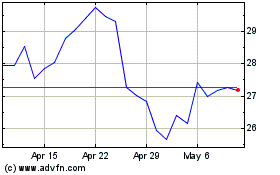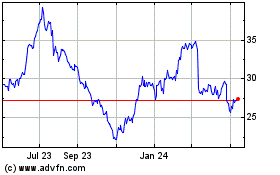Southwest Incident Linked to Cracked Engine Blade
September 12 2016 - 6:20PM
Dow Jones News
The U.S. aviation-safety watchdog on Monday linked a cracked
jet-engine fan blade to the emergency landing of a Southwest
Airlines Co. plane last month, as part of its preliminary
investigation to identify the cause of the unusual incident.
The National Transportation Safety Board has yet to conclude the
root cause of what happened but said it found cracking consistent
with metal fatigue on a remaining piece of one of the engine's
broken fan blades. The engine was made by General Electric Co.'s
joint venture CFM International with France's Safran SA.
None of the 99 passengers or five crew aboard were injured
during the flight from New Orleans to Orlando, Fla., which was
forced to land in Pensacola, Fla., on Aug. 27 after the rare engine
failure, which caused major engine damage and led to
depressurization of the cabin.
The failure of a fan blade is a rare event, and engines are
designed to contain them inside the engine casing or to eject any
debris safely out of the back. The failure aboard the Southwest jet
was characterized as uncontained by the NTSB, meaning debris was
ejected out of the sides of the engine, an extremely unusual
event.
The failure of one of the engine's 38 front fan blades appeared
to precede the significant damage sustained by the CFM engine
nacelle, according to an industry official, followed by the
complete separation of the forward inlet. The NTSB said debris from
the inlet damaged the Boeing Co. 737-700 jet's fuselage, wing and
tail stabilizers.
The CFM56-7 series engine involved in the accident was one of
the oldest in service, according to the official. However, the age
of an engine and its internal components aren't necessarily related
as parts are refurbished or replaced during the life of an
engine.
An NTSB spokesman said the agency's investigation is ongoing and
a sequence of events wasn't included in its preliminary findings. A
Southwest Airlines spokesman said repairs to the jet have begun and
the company continues "to work closely with the NTSB on the
investigation of this unique and extremely rare event."
Aircraft and their engines are subjected to repeated stresses
during their life in service and cracks are a normal part of their
aging, but if left unchecked, they can cause major damage to an
aircraft. Regulators, airlines and manufacturers have developed
inspection regimes to identify and remedy cracks before they become
safety issues.
The source of the cracking on the titanium alloy blade was still
under investigation, and the NTSB said it was continuing to review
the engine's maintenance records and test the remaining blades.
CFM is the biggest engine manufacturer in the world for
single-aisle aircraft, such as the workhorse Boeing 737.
Write to Jon Ostrower at jon.ostrower@wsj.com
(END) Dow Jones Newswires
September 12, 2016 18:05 ET (22:05 GMT)
Copyright (c) 2016 Dow Jones & Company, Inc.
Southwest Airlines (NYSE:LUV)
Historical Stock Chart
From Mar 2024 to Apr 2024

Southwest Airlines (NYSE:LUV)
Historical Stock Chart
From Apr 2023 to Apr 2024
